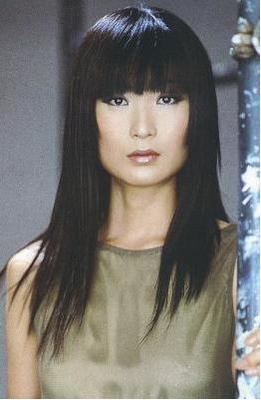 The Straight Story on Asian Hair
The Straight Story on Asian Hair
Seon-Ha Kim has been working as a hairdresser in New Jersey for almost twelve years, and is about to open her own salon. She hasn't settled on the location or name yet, but one thing is certain--this salon will reflect her specialization in what she calls "East Asian hair".
Most Asian girls are near-religious about exclusively patronizing Asian-run salons. It isn't entirely a cultural preference, as most girls were born and raised in America. "One of my favorite experiences from working in a salon," says Kim, "was when this Korean adoptee girl came with a friend. She had never been to an Asian salon before, and she was amazed at the difference in just a simple haircut. Asian hair is very different. It is usually so straight and heavy that every mistake will show, so you must be extra careful when cutting it. The strands are also rounder and thicker, and even coarse compared to the hair of Caucasian women."
Many girls come in for color treatments--the darkness of Asian hair makes it difficult to dye or highlight at home--but Kim would say that one of the most popular requests is hair straightening. It's also known as Japanese straightening, ionic perm--but in Korean salons, you'll know it as "Magic Straight".
As the names might suggest, it renders hair permanently and perfectly straight. "It's very different from a normal chemical relaxer," says Kim. "Those are too harsh and leaves hair very dry, especially Asian hair. Magic Straight is more expensive and takes hours longer, but it will make your hair soft and silky. People often ask why Asian girls want this treatment when their hair is already straight--but it's not always a fine kind of straight. The strands are thicker, so it won't always lie flat. Magic Straight makes it look and feel smooth."
The straightening treatment isn't cheap--the most exclusive salons can charge over $700 (though smaller salons can charge as little as $200), but Kim urges you not to skimp on a treatment that affects the very structure of the hair, loosening and reshaping protein bonds on the molecular level. It includes several chemical solutions, sitting under a heater for almost an hour, and specialized flatirons meticulousy applied to one-inch sections of hair. "The best salons put at least two stylists to work on one person at once," says Kim. The result of 4-5 hours at a salon is enviably sleek and easy to maintain.
"I'm addicted to it," gushed Jane Chen, a development associate at a nonprofit organization in downtown Manhattan, and one of Kim's most faithful clients. "It's the best treatment ever. It makes your hair look perfectly blow-dried every moment of every day, even just after you wake up."
She is one of many Asian women who make a yearly ritual of this treatment. The treated hair remains perfectly sleek "forever", but "I do it to touch up the roots."
The Magic Straight is followed by two days of strictly avoiding shampoo, water, and all hair accessories. Kim even warns her clients to avoid tucking their hair behind their ears, lest they permanently bend their hair in that curve.
What about girls who are unwilling to invest so much time and money into the Magic Straight?
"It can be simple things," answers Kim. "If your area has hard water, I always suggest installing a shower filter. And using shampoo with lower pH levels--most drug store shampoos are too drying. Most of the Asian girls I see shampoo their hair too often, even if they have dry hair to begin with. So I recommend a leave-in conditioner like Biosilk Silk Therapy, even if it's just for the ends. Also, the diet. Most Asian women eat a lot of fish, seaweed, and tofu, which help hair stay thick and grow fast. That's good, but then they don't get enough eggs and dairy, which provides calcium and other important nutrients for hair to keep it smooth and strong."
When she opens her salon, Kim plans to offer optional free fifteen-minute consultations about style, something not many Asian salons offer. "It's because most clients have very firm ideas about what they want--Korean girls especially, and a lot of ties, that depends on what popular drama is playing!" she says with a laugh. "But I'm always willing to offer advice for flattering styles. I take many things into consideration--the shape of the face and head first. Short, chin-length hair [the quintessential Asian schoolgirl style] looks so clean and sharp on someone with a slim oval face. A rounder or a squarer-cut face usually looks best with longer layers. I love suggesting ways to wear the hair, too, not just the cut--for example, this summer in Korea, the apple hairstyle was very popular." (The apple hairstyle is named for a tiny ponytail at the crown of the head, as it supposedly resembles the stem of an apple.)
"Even things like a girl's height can make one style better than another. Long hair to the waist (Jun Ji-hyun's trademark style, which was cut last spring to the outcry of many fans) can make a woman very striking, especially if she's tall--but on a very small woman, it can just look heavy. Oh--I hear lots of requests for long waves right now." She thinks this has something to do with the recent prominence of Asian women like Riyo Mori and Honey Lee in international pageants. "And looks are only one factor. I also ask how much time they want to spend on their hair every day. Some women are happy to spend an hour on their hair in the morning--some women want to only spend five minutes."
Her goal?
"I'm in this business to make women look and feel prettier," she smiles.
 The Straight Story on Asian Hair
The Straight Story on Asian Hair